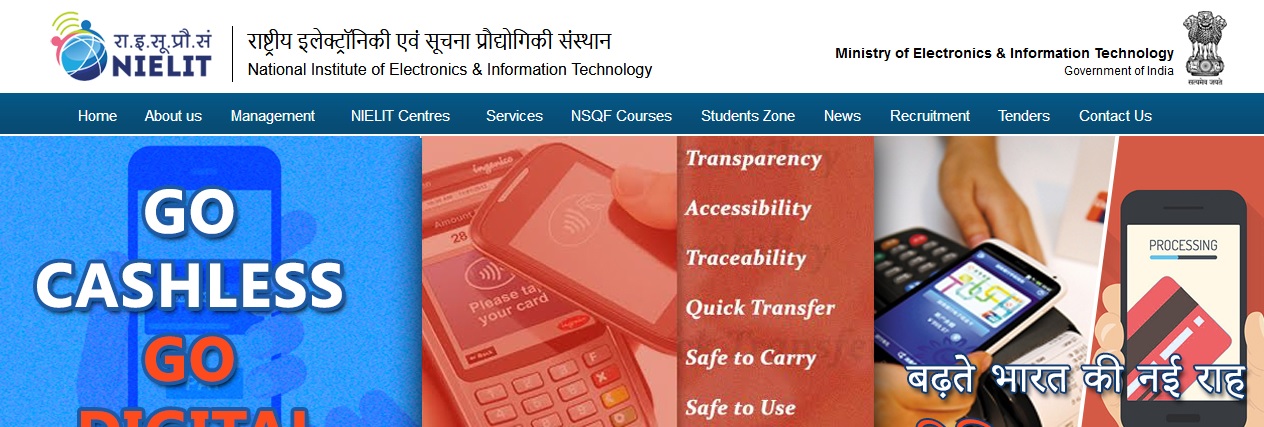NIELIT Question Paper : C Level Course Information Security
Institute : National Institute of Electronics and Information Technology (nielit.gov.in)
Course : C Level Course
Subject Code/Name : C8-R4/Information Security
Document Type : Old Question Paper
Location : India
Website : nielit.gov.in
Download Model/Sample Question Paper :
January 2012 : https://www.pdfquestion.in/uploads/nielit.in/7106-jan12C8-R4.pdf
JULY 2012 : https://www.pdfquestion.in/uploads/nielit.in/7106-jul12C8-R4.pdf
January 2013 : https://www.pdfquestion.in/uploads/nielit.in/7106-jan13C8-R4.pdf
JULY 2013 : https://www.pdfquestion.in/uploads/nielit.in/7106-jul13C8-R4.pdf
January 2014 : https://www.pdfquestion.in/uploads/nielit.in/7106-jan14C8-R4.pdf
July 2014 : https://www.pdfquestion.in/uploads/nielit.in/7106-jul14C8-R4.pdf
NIELIT C Level Course Sample Question Paper
C8-R4:
NOTE:
Time: 3 Hours
Total Marks: 100
Related : National Institute of Electronics & Information Technology C Level Course Advanced Computer Graphics Paper 2017 : www.pdfquestion.in/13076.html
Information Security July 2011
1. a) How are cryptographic system characterized? Explain each characteristic in one line.
b) Explain encrypt-decrypt-encrypt variant of DES.
c) Explain Blum-Blum-Shub approach for generating secure pseudo random numbers.
d) Explain a situation in cryptography in which an attack based on birthday paradox is possible.
e) Perform an attack on RSA algorithm when Æ(n) is known.
f) Find the multiplicative inverses of all nonzero elements of Z7.
g) Write an algorithm to test the primality of integer n where n=2kq, k, q are integers k > 0, q is odd. (7×4)
2. a) What do you mean by cryptanalysis? Explain differential cryptanalysis attack on DES.
b) Explain output feedback mode of DES. Compare it with cipher feedback mode.
c) What do you mean by ‘confusion’ and ‘defusion’? (8+8+2)
3. a) Explain ANSI X 9.17 PRNG standard. What are the factors responsible for the strength of the method?
b) Write the algorithm for ElGamal encryption and decryption.
c) How ‘main-in-the-middle’ attack can be performed on Diffie-Hellman key exchange algorithm? (6+8+4)

4. a) What are characteristics of cryptographic hash function?
b) What is RIPEMD-160? Write pseudo-code for it.
c) Write the four stages in AES. Explain each to the point. (4+8+6)
5. a) Define digital signatures. Explain digital signature standard based on RSA algorithm
b) Give the steps for constructing GF(2m) and hence give the elements of GF(24).
c) Where do we use random numbers in cryptography? Write the criteria used to validate a sequence of numbers to be random. (8+6+4)
6. a) What is Message Authentication Code? Write four situations where it is used.
b) Explain Message Authentication Code based on DES.
c) Write a hash function giving rise to a hash value having effectiveness of 2-128. (6+8+4)
7. a) Explain RC-4 stream cipher, also giving the algorithm.
b) Explain the key distribution scenario in which each user shares a unique master key with the key distribution centre. (9+9)
Information Security July 2012
C8-R4: Information Security :
1. a) Compare and contrast attacks on digital signatures with attack on cryptosystem.
b) Distinguish between public and private keys in an asymmetric key cryptosystem. Compare and contrast the keys in symmetric key and asymmetric key cryptosystems.
c) Define cryptographic hash function. Explain three criterions for a cryptographic hash function.
d) Which security mechanism(s) are provided in each of the following cases?
i) A company demands employee identification and a password to let employee log into the company server.
ii) A company server disconnects an employee, if he is logged into the system for more than two hours.
iii) A teacher refuses to send students grades by email unless they provide identification assigned by the teacher.
iv) A bank requires the customer’s signature for a withdrawal.
e) List the main characteristics of the SHA 512 cryptographic hash function.
f) Define a session key and show how a KDC can create a session key between Alice and Bob.
g) AES has a larger block size than DES. Is this an advantage or disadvantage? Explain. (7×4)
2. a) Define linear congruence. What algorithm can be used to solve an equation of type ax b (mod n)? How can a set of linear equations be solved?
b) Compare DES and AES. Which one is bit-oriented? Which one is byte oriented? Why only one substitution table (S box) is needed in AES but several in DES? Why are expansion and compression permutations required in DES, but not in AES?
c) Briefly answer following questions with respect to ElGamal cryptosystem:
i) What is the one way function in this system?
ii) What is the trapdoor in this system?
iii) Define the public and private keys in this system.
iv) Describe the security of this system. (4+6+8)
3. a) In the Diffie-Hellman protocol, what happens if x and y have same value, that is Alice and Bob have accidentally chosen the same number? Are R1 and R2 the same? Do the session keys calculated by Alice and Bob have the same value? Give an example to prove your claims.
b) i) What is the role of compression and encryption in the operation of a virus?
ii) What is the difference between an unconditionally secure cipher and a computationally secure cipher?
c) Which security service(s) are guaranteed for each of the following methods used to send mail at the post office?
i) Regular mail
ii) Regular mail with delivery conformation
iii) Regular mail with delivery and receipt signature
iv) Certified mail
v) Insured mail
vi) Registered mail